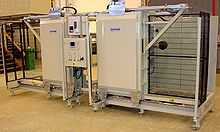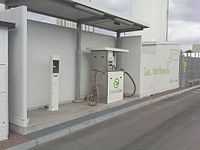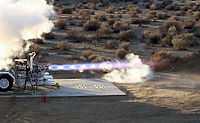Gases
A gas has the characteristic of being a substance which expands freely to fill any space.
Its atoms or molecules remain independent subject to temperature or pressure.
Theoretical gases
Def. any "matter that can be contained only if it is fully surrounded by a solid (or in a bubble of liquid) (or held together by gravitational pull)"[1] is called a gas.
The ideal gas laws describe a theoretical gas.
Def. relating "to, or existing as, gas"[2] is called gaseous.
Inert gases
Def. a "gas which does not undergo chemical reactions"[3] is called an inert gas.
Noble gases
Def. any "of the elements of group 18 of the periodic table, being monatomic and (with very limited exceptions) inert"[4] is called a noble gas.
Def. any "monatomic and (with very limited exceptions) inert"[4] gas is called a noble gas.
Gaseous objects
Gaseous objects have at least one chemical element or compound present in the gaseous state. These gaseous components make up at least 50 % of the detectable portion of the gaseous object.
Hydrogens


Molecular hydrogen gas is excited in the discharge tube shown on the right. When an electron returns to a lower energy orbital state the purple color is observed.
"Molecular hydrogen (H2) [is] a colourless, odourless and flammable gas at room temperature."[5]
"The familiar red H-alpha [Hα 656 nm] spectral line of hydrogen gas, which is the transition from the shell n = 3 to the Balmer series shell n = 2, is one of the conspicuous colors of the universe. It contributes a bright red line to the spectra of emission or ionization nebula, like the Orion Nebula, which are often H II regions found in star forming regions. In true-color pictures, these nebula have a distinctly pink color from the combination of visible Balmer lines that hydrogen emits."[6]
A "high-resolution spectrum of the Becklin-Neugebauer (BN) infrared point source located in [the region of the Orion Nebula] ... with the Steward Observatory 2.29 m (90 inch) telescope ... [confirmed] the reality of [the 2.12 μ] line ... on 1976 January 15 and 16. The line was then identified by R. Treffers as the S(1) line of the 1-0 vibration-rotation quadrupole spectrum of H2. Six other lines of the same band were also found. The presence of two of our lines has been confirmed by Grasdalen and Joyce (1976). Electronic transitions of interstellar H2 have previously been observed in the ultraviolet (Carruthers 1970; Smith 1973; Spitzer et al. 1973)."[7]
Heliums

Helium is a "colorless and inert gas".[8]
Helium is a noble gas.
Nitrogens

"Molecular nitrogen (N2) [is] a colorless, odorless gas at room temperature."[9]
Oxygens

"Molecular oxygen (O2) [is] a colorless, odorless gas at room temperature."[10]
Fluorines

The set of images on the right compare the color of air (1) with fluorine (2) and chlorine (3) gases.
Neons

Neon is a noble gas.
Chlorines

Chlorine is a "toxic, green gaseous chemical element".[11]
Argons

Argon is a noble gas.
Kryptons

Krypton is a noble gas.
Xenons

Xenon is a "heavy, gaseous chemical element ... of the noble gases group".[12]
Mercuries

Radons
Radon is "one of the noble gases."[13]
Technology

Estimated 2013 U.S. fractional helium use by category. Total use is 47 million cubic meters.[14]



"Turbines have been around for a long time—windmills and water wheels are early examples. The name comes from the Latin turbo, meaning vortex, and thus the defining property of a turbine is that a fluid or gas turns the blades of a rotor, which is attached to a shaft that can perform useful work."[15]
"A gas detector is a device which detects the presence of various gases within an area"[16] or volume.
"The combination of nanotechnology and microelectromechanical systems (MEMS) technology allows the production of a hydrogen microsensor that functions properly at room temperature. One type of MEMS-based hydrogen sensor is coated with a film consisting of nanostructured [indium(III)] indium oxide (In2O3) and tin oxide (SnO2).[17] A typical configuration for mechanical Pd-based hydrogen sensors is the usage of a free-standing cantilever that is coated with Pd.[18][19] In the presence of H2, the Pd layer expands and thereby induces a stress that causes the cantilever to bend. Pd-coated nano-mechanical resonators have also been reported in literature, relying on the stress-induced mechanical resonance frequency shift caused by the presence of H2 gas. In this case, the response speed was enhanced through the use of a very thin layer of Pd (20 nm). Moderate heating was presented as a solution to the response impairment observed in humid conditions.[20]"[21]
"Care for the environment is becoming more and more of an issue in business today, also in the transport sector and liquid methane gas is a good alternative for diesel fuel."[22]
"Liquid methane gas and diesel fuel are used in combination. When the liquid methane gas and the diesel fuel are mixed in a proportion of 75-25 a truck can run 500 to 1000 km. depending on the driving circumstances."[22]
"The use of the liquid gas depends on economies that are made by using it. The gas is cheaper. One kilo (liquid methane is expressed in kilos) costs less than one litre of diesel and contains 35% more energy. A truck running on it, is far more expensive though. A normal truck costs 100.000 Euro, a truck running on liquid gas, 35.000 Euro more. And also the refuelling possibilities are restricted. Some more facilities are planned though."[22]
"Rocket engines aren't exactly synonymous with liquid methane, but NASA's latest project shows just what this natural gas is capable of -- produces 7,500-pound thrust in this case. Best of all, "you don't have to put on a HAZMAT suit to handle it like fuels used on many space vehicles.""[23]
See also
References
- ↑ "gas, In: Wiktionary". San Francisco, California: Wikimedia Foundation, Inc. 16 April 2015. Retrieved 2015-04-20.
- ↑ "gaseous, In: Wiktionary". San Francisco, California: Wikimedia Foundation, Inc. September 29, 2013. Retrieved 2013-10-05.
- ↑ "inert gas, In: Wiktionary". San Francisco, California: Wikimedia Foundation, Inc. 5 October 2014. Retrieved 2015-04-20.
- 1 2 "noble gas, In: Wiktionary". San Francisco, California: Wikimedia Foundation, Inc. 16 December 2014. Retrieved 2015-04-20.
- ↑ "hydrogen, In: Wiktionary". San Francisco, California: Wikimedia Foundation, Inc. September 1, 2013. Retrieved 2013-10-05.
- ↑ "Balmer series, In: Wikipedia". San Francisco, California: Wikimedia Foundation, Inc. February 2, 2012. Retrieved 2012-07-11.
- ↑ T. N. Gautier II and Uwe Fink, Richard R. Treffers, and Harold P. Larson (July 15, 1976). "Detection of Molecular Hydrogen Quadrupole Emission in the Orion Nebula". The Astrophysical Journal 207 (07): L129-33. doi:10.1086/182195. http://adsabs.harvard.edu/full/1976ApJ...207L.129G. Retrieved 2013-10-05.
- ↑ "helium, In: Wiktionary". San Francisco, California: Wikimedia Foundation, Inc. October 1, 2013. Retrieved 2013-10-05.
- ↑ "nitrogen, In: Wiktionary". San Francisco, California: Wikimedia Foundation, Inc. September 22, 2013. Retrieved 2013-10-05.
- ↑ "oxygen, In: Wiktionary". San Francisco, California: Wikimedia Foundation, Inc. September 16, 2013. Retrieved 2013-10-05.
- ↑ "chlorine, In: Wiktionary". San Francisco, California: Wikimedia Foundation, Inc. August 28, 2013. Retrieved 2013-10-05.
- ↑ "xenon, In: Wiktionary". San Francisco, California: Wikimedia Foundation, Inc. October 5, 2013. Retrieved 2013-10-05.
- ↑ "radon, In: Wiktionary". San Francisco, California: Wikimedia Foundation, Inc. September 27, 2013. Retrieved 2013-10-05.
- ↑ U.S. Department of the Interior, U.S. Geological Survey (2014). "Helium". Mineral Commodity Summaries 2014. pp. 72–73. http://minerals.usgs.gov/minerals/pubs/commodity/helium/mcs-2014-heliu.pdf.
- ↑ Lee S. Langston (July-August 2013). "The Adaptable Gas Turbine". American Scientist. http://www.americanscientist.org/issues/pub/2013/4/the-adaptable-gas-turbine. Retrieved 2013-10-05.
- ↑ "Gas detector, In: Wikipedia". San Francisco, California: Wikimedia Foundation, Inc. May 17, 2013. Retrieved 2013-05-26.
- ↑ Gustavo Alverio. "A Nanoparticle-based Hydrogen Microsensor". University of Central Florida. Retrieved 2008-10-21.
- ↑ D.R. Baselt. "Design and performance of a microcantilever-based hydrogen sensor". Sensors and Actuators B.
- ↑ Sumio Okuyama. Hydrogen Gas Sensing Using a Pd-Coated Cantilever. Japanese Journal of Applied Physics. http://jjap.jsap.jp/link?JJAP/39/3584/. Retrieved 2013-02-26.
- ↑ Jonas Henriksson. "Ultra-low power hydrogen sensing based on a palladium-coated nanomechanical beam resonator". Nanoscale Journal.
- ↑ "Hydrogen sensor, In: Wikipedia". San Francisco, California: Wikimedia Foundation, Inc. March 16, 2013. Retrieved 2013-05-26.
- 1 2 3 holander (7 September 2012). "Liquid methane gas alternative for diesel fuel". The Netherlands: holander.nl. Retrieved 2015-06-16.
- ↑ NASA (19 July 2008). "Liquid Methane-Powered Rocket Engine". TecheBlog. Retrieved 2015-06-16.
External links
| |||||||||||||||||||||||||||||||||||
![]() This is a research project at http://en.wikiversity.org
This is a research project at http://en.wikiversity.org
| |
Development status: this resource is experimental in nature. |
| |
Educational level: this is a research resource. |
| |
Resource type: this resource is an article. |
| |
Resource type: this resource contains a lecture or lecture notes. |
| |
Subject classification: this is a chemistry resource . |
